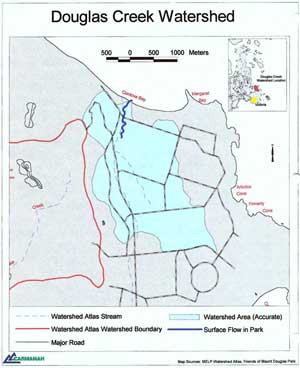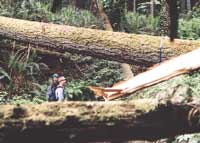

|
The Douglas Creek watershed covers 524 hectares. It is located in the district of Saanich on southern Vancouver Island.
One hundred and forty years of development has changed the watershed from forest to farm, to its present state of 5000 properties.
However, the developed portion of the watershed is having an ongoing impact on stream habitat. |

|
|
The problems are typical of urbanized watersheds everywhere - erratic water quantity due to a high percentage of impervious area, degraded water quality, and diminished aquatic ecosystem biodiversity. The stream channel shows all the effects of seasonal flood water - eroded stream banks, a channel that is deeply incised into a clay substrate, gravel loss, and a lack of large woody debris. Pollutants enter the stream as chemicals from automobiles, lawns and driveways.
Continued urbanization is having an impact on this locally important stream. |

|
FRIENDS OF MOUNT DOUGLAS PARK SOCIETY
The society has been constantly battling invasive plants such as ivy and broom which are taking over fragile ecosystems. |
|
PROJECTS
At the outset, the Friends of Mount Douglas Park Society realized that the stream's restoration was a long-term project. The group has undertaken water quality and quantity monitoring, benthic sampling, salmonid transplant, and in-stream habitat enhancement.
The Friends of Mount Douglas Park Society is committed to restoring what they can as opportunities present themselves. |
Bob Bridgeman, Director for Streams
Friends of Mount Douglas Park Society
1481 Elnido Road
Victoria, BC, V8N 4Z7
Email: rbridge@shaw.ca
Tom Rutherford
Community Advisor for Lower Vancouver Island,
including the southern Gulf Islands and Cowichan River Watershed
Fisheries and Oceans Canada
Box 241 - 5653 Club Road
Duncan, BC, V9L 3X3
Phone: 250-746-5137
Fax: 250-746-8397
Email: RutherfordT@dfo-mpo.gc.ca
Web: Fisheries and Oceans Canada - Community Advisors
June 20, 2003
February 20, 2006